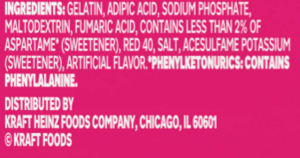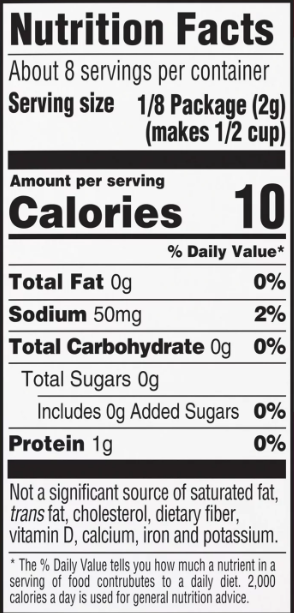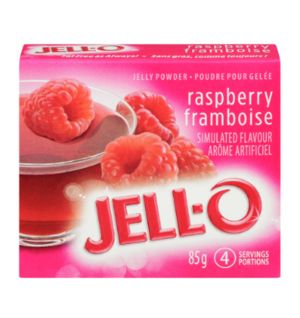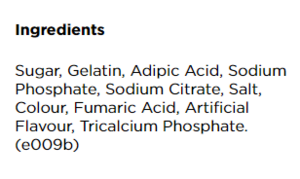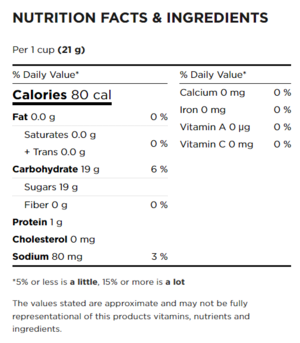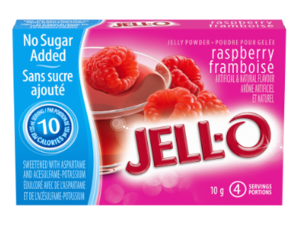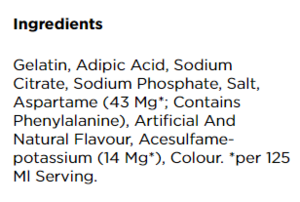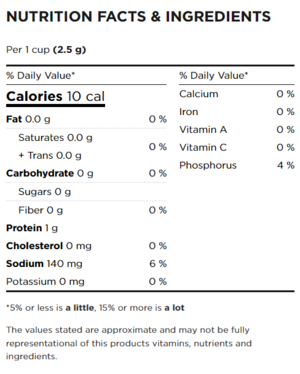Course:FNH200/Projects/2023/The Processing and Regulation of Raspberry Jell-O
Introduction
You're a teenager at lunch opening your lunch bag to see what your mother has packed you. You peer inside- a sandwich, some carrots, a water bottle, and, what's this? A small serving of Jell-O. It has been years since you've last had a Jell-O packed into your lunch bag, what's it doing here? You think back on it as you pull out the small container with red Jell-O, the best flavor, in your opinion. Ripping open the seal on the Jell-O cup, you breath in the sweet aroma. You take a spoonful of the Jell-O and feel the same eagerness as you did when you were a kid. The gelatin treat dissolves as soon as it hits your mouth and you taste the sweet subtlety of different flavours and the smoothness of the Jell-O. Nothing about this treat has changed and it brings you as much joy as it did when you were a kid. "I hope I can eat Jell-O all my life" you say to yourself before scarfing down the rest of the treat.
A registered trademark of Kraft Heinz, Jell-O is an American Brand that offers a variety of fruit flavoured gelatin based desserts, pudding, and no-bake pie mixes that comes in many Ready-to-make, premade, and prepackaged forms.
Photos and Ingredient Analysis
Photos
Ingredients Analysis
Classic Jell-O
- In USA: Sugar, Gelatin, Adipic Acid, Artificial Flavor (Less than 2%), Disodium Phosphate, Sodium Citrate, Red 40, Fumaric Acid, Natural Flavor.
- In Canada: Sugar, Gelatin, Adipic Acid, Sodium Phosphate, Sodium Citrate, Salt, Colour, Fumaric Acid, Artificial Flavour, Tricalcium Phosphate.
- The main ingredients in Jell-O are sugar, gelatin, and adipic acid. American Jell-O contains both natural and artificial flavourings while Canadian Jell-O is made of only aritifical flavourings. Canadian Jell-O also has one extra additive which is Tricalcium Phosphate.
Sugar Free Jell-O
- In USA: Gelatin, Adipic Acid, Sodium Phosphate, Maltodextrin, Fumaric Acid, Aspartame (Less than 2%), Red 40, Salt, Acesulfame Potassium, Artificial Flavor, Phenylketonurics: Contains Phenylalanine.
- In Canada: Gelatin, Adipic Acid, Sodium Citrate, Sodium Phosphate, Salt, Aspartame (Contains Phenylalanine), Artificial And Natural Flavour, Acesulfame-potassium, Colour.
- The main ingredients in sugar free Jell-O are gelatin and adipic acid. Both American and Canadian Jell-O use aspartame and acesulfame potassium as sugar substitution.
Processing and Preservation
Jell-O is processed using partial hydrolysis and pre-gelantinization[1]. The gelatin is extracted from collagen and a controlled heating process breaks down the collagen into smaller peptides which increases the solubility of the gelatin. After this the mixture is spray dried to remove any moisture from the gelatin[2]. Once a dry powder is left flavours and color mixes are put in before it's packaged for distribution. Jell-O has a long shelf life as long as it's preserved properly. The absence of water discourages microorganisms to feed and thrive. Furthermore the sealed packaging prevents external environmental factors from affecting the product. All this combined creates a very stable shelf product.
History and Production
An American classic that has been around since 1897, Jell-O is an ultra-processed gelatin based dessert that is offered in Strawberry, Raspberry, Orange, and Lemon flavouring[3].
Though the brand name of Jell-O is a recent development, forms of gelatin, the primary ingredient of Jell-O, have existed for a long while.
Early iterations were used by the Ancient Chinese and Ancient Egyptians as a therapeutic and food agent[4]. Around the turn of the 15th century, medieval cooks used the gelatin made from the broths of boiled pigs ears and feet for more popular and savory products[4][5]. Alternative forms of gelatin developed thereafter such as fish jellies, derived from eels, made in response to Catholic practices, pectin[6], derived from fruits, to create sweet jellies that also act as a preservative, or even agar-agar[7], derived from seaweed, to act as a 1:1 substitute to gelatin for vegetarians/vegans.
Today, gelatin is synthetized from animal collagen, a protein that makes up connective tissues such as skin, tendons, bones and cartilage and is primarily extracted from the boiled, dried, treated, and filtered hides and bones of cows and pigs[5][7]. The extracted gelatin is then made into either a sheet, or in Jell-O's case, a powder[4] which can then be mixed, following the long standing recipe, with sugar or it's alternative, colouring, flavouring, and preservatives, additives, or enhancers to make the Jell-O we all know and love.
Once packaged in a heat treated and sealed packaging, the Jell-O powder packs are then boxed in smaller carboard packages to prevent from damage in travel[3] and then sent off to stores where consumers are able to purchase all sorts of different flavours. To finish making the dessert, consumers dissolve the powder in cold water to hydrate the granules of gelatin and dissolve the sugar and additives. The mixture is then heated to allow the collagen molecules to break from each other and integrate fully with the mixture. Finally, the mixture is put into the fridge to rebind the hydrated gelatin molecules and turn the liquid into a semi-solid state[7].
All this to say, the quick and easy snack called Jell-O has been around for a while and has only grown to be loved world wide and come in numerous different flavours.
Unfortunately, Jell-O, in it's brand name form, is not available in a vegan/vegetarian option, though one can take comfort in knowing that there are alternatives on the market like the highly popular BaKol Jel Dessert[8]. Additionally, while the popular saying is that Jell-O is made from horse hooves, it is incorrect to assume so, as horse hooves are made of keratin which cannot synthesize collagen or be made into gelatin[7].
In Depth Production
Classic Jell-O
The production of Jell-O is similar in both the United States and Canada, with some variations. In general the process is as follows:
- Dry ingredients such as Gelatin, sugar, adipic acid, artificial flavor, disodium phosphate, sodium citrate, and fumaric acid are measured and mixed together.
- Artificial flavour compounds and colours are mixed in.
- The blended mixture undergoes processing such as agglomeration[9] to form granules to improve dissolution of the Jell-O powder.
- The mixture is packaged up and sent to quality control before it's sent off for distribution.
In the USA
- In the United States they use Red 40 to give Jell-O it's signature colour.
- Disodium Phosphate is a specific sodium phosphate compound generally used as an acidity regulator and as an emulsifier[10].
In Canada
- There is no direct specification on what colouring product is used in Canada, however because Red 40 is a widely used food colouring product we can assume it's likely the same one used here.
- Sodium phosphate is a broader term encompassing various compounds that contain both sodium and phosphate ions. Disodium phospate as listed in the USA ingredients falls under the Sodium phosphate group.
- There is no information on why the Canadian variation has tricalcium phosphate, but there are a few things we can infer. Tricalcium phosphate is a good source of calcium[11] and it's possible that it's added as a method of calcium fortification[11]. Another use case of Tricalcium phosphate is that it prevents caking and clumping and could be used to prolong shelf life of the product[11].
Sugar Free Jell-O
The production of sugar free Jell-O is the same as the production of classic Jell-O with the exception of substituting regular sugar with aspartame and acesulfame potassium.
In the USA
- Phenylketonurics is listed because it's required by the FDA to alert people who may have phenylketonuria[12]. This isn't required in Canada.
- Maltodextrin is a flavouring agent[13] and this could be used instead of sodium citrate which is used in Canada for flavouring.
In Canada
- Sodium Citrate is a flavouring agent[14] and could possibly be a replacement for maltodextrin. There is no definitive reason why this is used instead.
Health Concerns
Heart Disease and Stroke
Heart disease and stroke are leading causes of death in Canada, responsible for 27.3% of all deaths[15]. Excess sugar consumption is associated with many negative health effects such as heart disease and stroke. Jell-O's high sugar content makes it potentially harmful for those who are consuming large amounts of Jell-O.
Cancer Association with Artificial Sweeteners
Aspartame
A 2022 study by NutriNet-Santé reported that adults who consumed higher amounts of aspartame were slightly more likely to develop any type of cancer (1.15 times the risk), breast cancer (1.22 times the risk), and obesity-related cancers (1.15 times the risk) than those who did not consume aspartame[16]. Sugar-free Jell-O contains 43 Mg of Aspartame, which is below the acceptable daily intake of 40 mg of aspartame per kilogram of body weight.
Acesulfame-Potassium
A 2022 study by NutriNet-Santé reported that adults who consumed Ccesulfame-K had 1.13 times the risk of cancer than those who did not consume acesulfame-K. No other studies have examined whether acesulfame-K is associated with cancer in people so there has not been a conclusive answer as to the safety of Acesulfame potassium [16]. Sugar-free Jell-O has 14 Mg of Acesulfame-Potassium. The acceptable daily intake of Acesulfame-Potassium is 15 mg per kilogram (mg/kg) of body weight per day in the U.S and Canada. Jell-O has a safe amount of Acesulfame-Potassium for most body weights.
Lack of Nutrition
Jell-O is a fun snack to have, but it's important not to rely on Jell-O as a staple in a healthy diet. Gelatin itself is a source of protein and contains essential amino acids, but Jell-O contains very little protein and mainly just sugars or sweeteners[17]. Although it is okay to eat as an occasional treat it lacks other nutrients that are important to live a healthy lifestyle.
Storage and Packaging
Storage and packaging of Jelly Powder in the US and Canada are the same.
Storage
When stored properly Jell-O powder could last for years[18]. In order to keep Jello powder from going bad, it is important to keep it stored in a cool, dry place away from direct sunlight, heat sources, and humidity. This helps prevent the moisture from affecting the powder. It's important to store Jell-O in an area where temperature fluctuations do not happen, when things go through temperature changes, the moisture in the air tends to condensate inside the packages. This moisture allows mold to grow and your Jell-O powder could go bad before the best before date[18].
Packaging
The powder is packaged in a Tetra Pak powder pouch that is further encased in a small cardboard box.
It's important to keep powder dry and protected from moisture. Jelly Powder, because of it's low water activity, is hygroscopic which means that it readily picks up moisture. This is why the main requirement for packaging would be that there must be no transmission of water vapour from the surrounding environment into the food. Packaging should also protect against oxygen and light. In Jell-O's case there is use of a Tetra Pak pouch to contain the powder, made from laminated plastic, aluminum and paper. This plastic bag is designed to keep the powdered gelatin mixture sealed and protected from moisture and other contaminants. It helps maintain the freshness and quality of the product until it's ready to be used[19].
Jell-O also has physical protection to prevent the powder from becoming crushed during distribution and handling. This physical protection is through a small cardboard box that holds the Tetra Pak. The paper box provides protection from outside particles as well as provides consumers with a place to store leftover Jello-O powder and prevent it from getting wet.
Exam Question
Question
-> The gelatin in Jell-O is synthesized from [Write/Fill], which is then grinded down into a [Write/Fill]. Because of this, it is important to [Write/Fill], which means that it is best to pack the powdered Jell-O in a [Write/Fill].
Correct Answer
->The gelatin in Jell-O is synthesized from animal collagen, which is then grinded down into a powder. Because of this, it is important to keep the powder dry, which means that it is best to pack the powdered Jell-O in a Tetra Pak.
Why is this important to know?
The key bits in looking at this project as a whole is to understand what Jell-O, or the gelatin in Jell-O, comes from and dispel some of the common misinformation about it (like it being synthesized from horse hooves) and to understand that because of it's production, it needs to have appropriate means of packaging for transportation. Knowing that the powder needs to be kept dry and still be accessible for a consumer in pre-portioned packages can easily lead you to think about smaller packing styles that keep liquid out and help you identify other products that follow similar guidelines.
References
- ↑ Holmes, ZoeAnn (1999). "What is Jell-O? How does it turn from a liquid to a solid when it cools?".
- ↑ "How it's made - Gelatin".
- ↑ 3.0 3.1 "Jell-O". Wikipedia.
- ↑ 4.0 4.1 4.2 "A History of Gelatine". MM Ingredients.
- ↑ 5.0 5.1 Heasman, Chris. "This Is How Jell-O Is Really Made". Mashed.
- ↑ Flutto, L. "Pectin| Properties and Determination". Science Direct.
- ↑ 7.0 7.1 7.2 7.3 Groves, Melissa. "Is Jello Good for You? Nutrition, Benefits, and Downsides". Healthline.
- ↑ Bruno, Joey. "Is Jello Vegan? The Answer And 5+ Vegan Jello Brands".
- ↑ "Jell-O". Wikipedia.
- ↑ Schaefer, Anna. "Is Disodium Phosphate Bad for You?".
- ↑ 11.0 11.1 11.2 Fanous, Summer. "What Is Tricalcium Phosphate?".
- ↑ "CFR - Code of Federal Regulations Title 21". U.S. Food & Drug Administration.
- ↑ "Maltodextrin". ScienceDirect.
- ↑ "Sodium Citrate". Wikipedia.
- ↑ "SUGAR, Heart Disease and Stroke".
- ↑ 16.0 16.1 "Artificial sweeteners and cancer risk: Results from the NutriNet-Santé population-based cohort study".
- ↑ "Jell-O, gelatin dessert, is popular. What's it made of?".
- ↑ 18.0 18.1 "How Long Does Jello Last?".
- ↑ "Tetra Pak powder handling".




